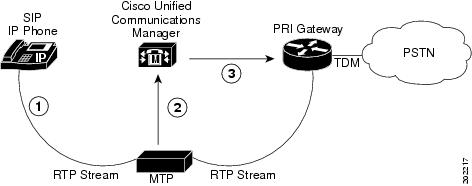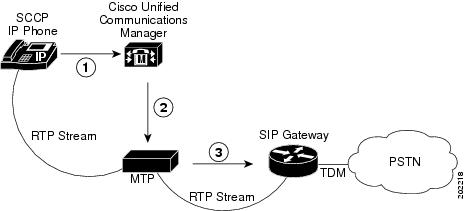I find that information in some sections are quite incomplete. e.g. SIP Line Side overview, CUCM SIP EndPoint overview vs B2BUA. Namely, it mentioned some phone models and not the other. Very terse with no background whatsoever.
Note, in the context of the documentation, there are two types of SIP protocol, Line Side SIP and Trunk Side SIP.
DTMF Interoperation between SCCP & SIP Phone (Section Media Termination Point (MTP) Devices)
You can configure Cisco Unified Communications Manager SIP devices (lines and trunks) to always use an MTP. If the configuration parameters are set to not use an MTP (default case), Cisco Unified Communications Manager will attempt to dynamically allocate an MTP if the DTMF methods for the call are not compatible. For example, phones that are running SCCP support only out-of-band DTMF, and Cisco Unified IP Phones using SIP (7905, 7912, 7940, 7960) support only RFC2833. Because the DTMF methods are not identical, Cisco Unified Communications Manager will dynamically allocate an MTP. If, however, a phone that is running SCCP that supports RFC2833 and out of band, such as Cisco Unified IP Phone 7971, calls a Cisco Unified IP Phone 7940 that is using SIP, Cisco Unified Communications Manager will not allocate an MTP because both phones support RFC2833. By having the same type of DTMF method supported on each phone, no need for an MTP exists.MTP Allocation for In-band vs Out-of-band Endpoints
Forward DTMF Digits From SIP Devices to Gateways or Interactive Voice Response (IVR) Systems for Dissimilar DTMF Methods
The following figure shows the MTP software device that is processing inband DTMF digits from the phone that is running SIP to communicate with the Primary Rate Interface (PRI) gateway. The RTP stream carries RFC 2833 DTMF, as indicated by a dynamic payload type.
The previous figure begins with media streaming, and the MTP device has been informed of the DTMF dynamic payload type.
- The phone that is running SIP initiates a payload type response when the user enters a number on the keypad. The phone that is running SIP transfers the DTMF inband digit (per RFC 2833) to the MTP device.
- The MTP device extracts the inband DTMF digit and passes the digit out of band to Cisco Unified Communications Manager.
- Cisco Unified Communications Manager then relays the DTMF digit out of band to the gateway or IVR system.
Generate DTMF Digits for Dissimilar DTMF Methods
As discussed in DTMF Relay Calls Between SIP Endpoints and Cisco Unified Communications Manager, SIP sends DTMF inband digits, while Cisco Unified Communications Manager only supports out-of-band digits. The software MTP device receives the DTMF out-of-band tones and generates DTMF inband tones to the SIP client.
The figure shown begins with media streaming, and the MTP device has been informed of the dynamic DTMF payload type.
- The SCCP IP phone user presses buttons on the keypad. Cisco Unified Communications Manager collects the out-of-band digits from the SCCP IP phone.
- Cisco Unified Communications Manager passes the out-of-band digits to the MTP device.
- The MTP device converts the digits to RFC 2833 RTP-compliant inband digits and forwards them to the SIP client.
SIP Standards Supported by CUCM
- RFC3261 RFC3262 (PRACK) RFC3264 (Offer/Answer) RFC3311 (UPDATE) 3PCC
- RFC3515 (REFER) Also Replaces and Referred-By Headers
- Remote Party Id (RPID) Header
- Diversion Header
- Replaces Header
- Join Header
- P-Charging-Vector Header
- RFC3265 + Dialog Package
- RFC3265 + Presence Package
- RFC3265 + KPML Package
- RFC3265 + RFC3842 MWI Package (Unsolicited Notify)
- Remotecc
- RFC4028 Session Timers
Cisco Unified Communications Manager Functionality on SIP Phones
- BLF Call Pickup
- Calling Party Normalization
- CTI Support
- Dial Plans
- Directed Call Pickup
- Do Not Disturb
- Do Not Disturb (DND) Call Reject
- DSCP Configuration
- E.164
- iX Media Channel
- Join and Join Across Lines
- Malicious Call Identification (MCID)
- Network Time Protocol (NTP)
- PLAR
- Programmable Line Keys
- Single Button Barge/cBarge
- Single Call UI
- SIP Profiles for Endpoints
- Soft Client Dual Registration
- Softkey Handling
- Unified Mobile Communications Server (UMCS) Integration
SIP OPTIONS
In Cisco Unified Communications Manager, the SIP OPTIONS method allows a SIP trunk to track the status of remote destinations. By sending outgoing OPTIONS and checking the incoming response message, the SIP trunk knows whether remote peers are ready to receive a new request. The SIP trunk does not attempt to set up new calls to unreachable remote peers; this approach allows for quick failovers.
Cisco Unified Communications Manager uses SIP OPTIONS as a keep-alive mechanism on the SIP trunk. Cisco Unified Communications Manager periodically sends an OPTIONS request to the configured destination address on the SIP trunk. If the remote SIP device fails to respond or returns a SIP error response, Cisco Unified Communications Manager tries to reroute the calls by using other trunks or by using a different address, depending on the configuration.
The OPTIONS request lies outside the context of a call; therefore, the request allows Cisco Unified Communications Manager to detect failures even if no calls are present on the SIP trunk. This approach allows any subsequent calls to be rerouted more quickly. The SIP OPTIONS method prevents calls from incurring large timeout and retry delays before the calls get rerouted.
Cisco Unified Communications Manager Configuration Tips
The following configuration tips apply to Cisco Unified Communications Manager Administration when a SIP trunk is configured for OPTIONS:
- Configure a SIP profile to enable SIP OPTIONS. (Use the menu option in Cisco Unified Communications Manager Administration.) Copy the Standard SIP Profile and rename the copy; for example, OPTIONS Profile. Check the Enable OPTIONS Ping to monitor destination status for trunks with service type "None (Default)" check box. SIP OPTIONS is disabled by default.
SIP Line Side Overview (as opposed to SIP Trunk Side)
The SIP line side feature affects Cisco Unified Communications Manager architecture, the TFTP server, and the Cisco Unified IP Phones. The phone features of the phone that is running SIP, which are equivalent to the phone features of the phone that is running SCCP, behave similarly. Cisco Unified IP Phones 7941/61/71/70/11 support all features and most CTI applications. Cisco Unified IP Phones 7905/12/40/60 support a reduced feature set (for example, limited MOH and failover capabilities). SIP trunk side applications work for both phones that are running SCCP and phones that are running SIP.



No comments:
Post a Comment